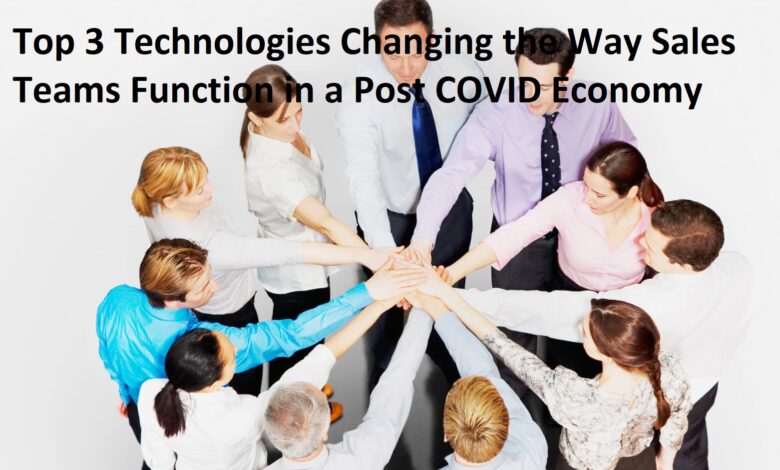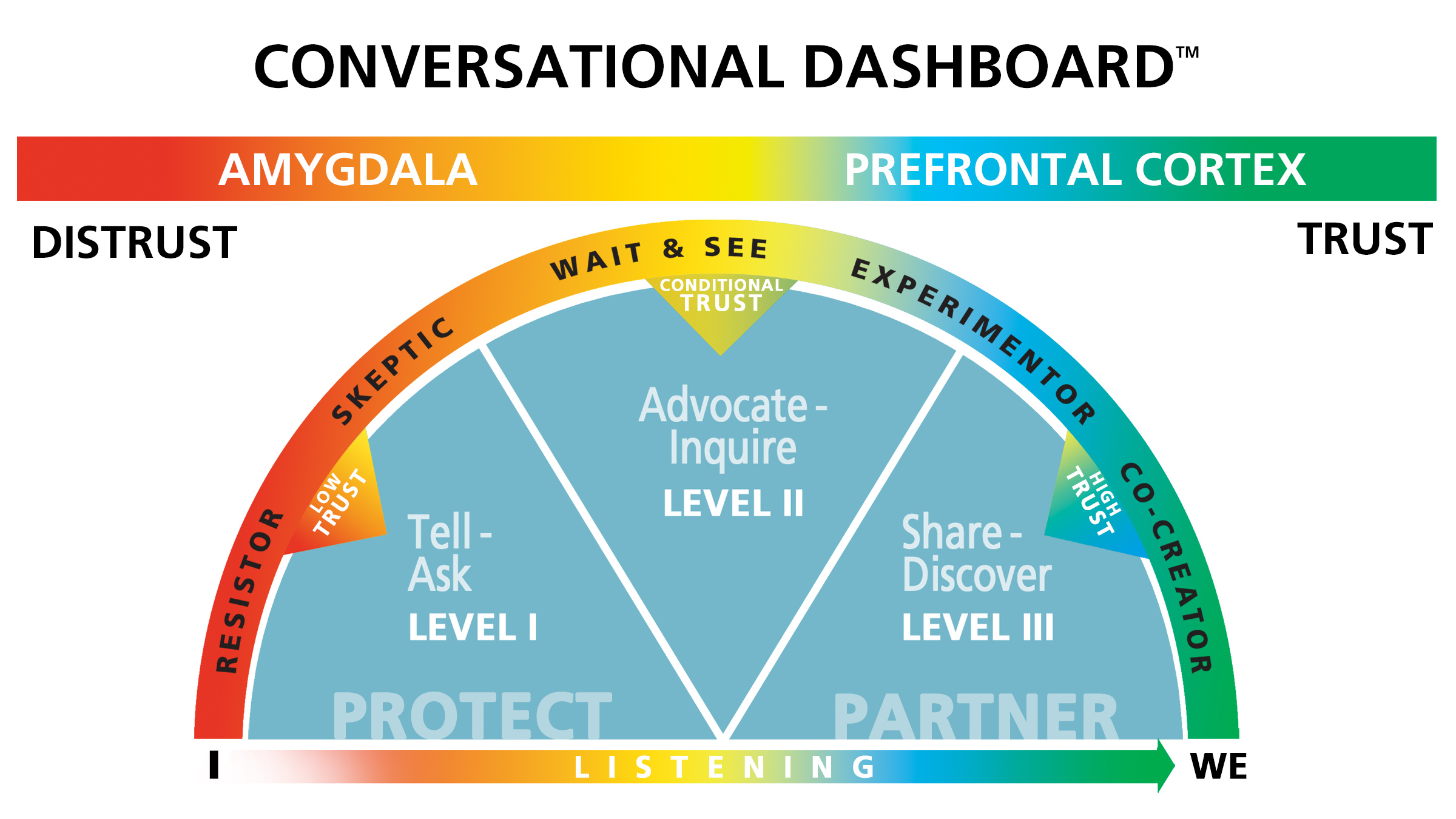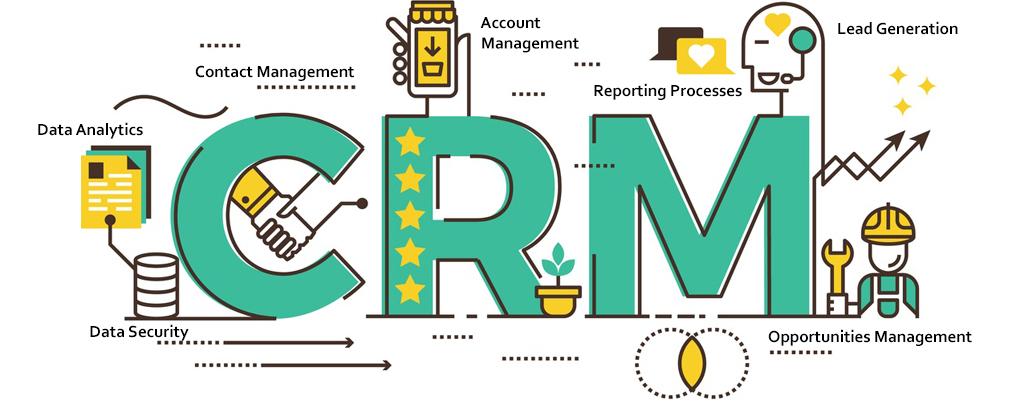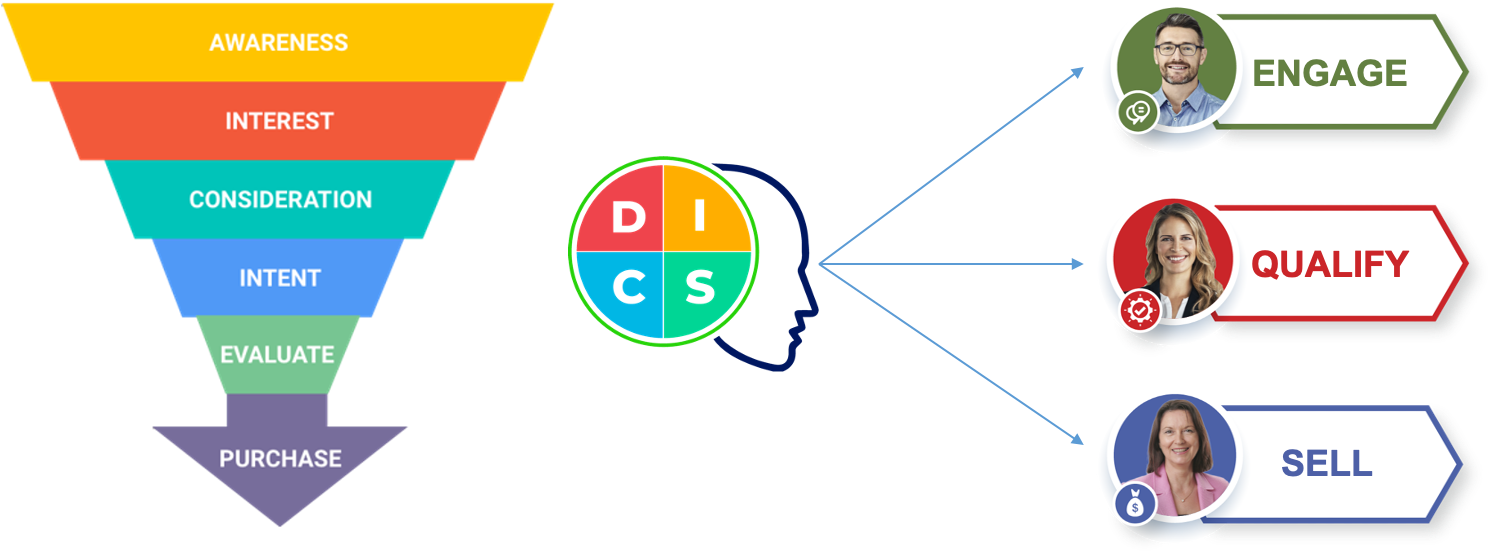Top 3 Technologies Changing the Way Sales Teams Function in a Post COVID Economy

Top 3 Technologies Changing the Way Sales Teams Function in a Post COVID Economy
Technologies Changing: Buyers and sellers were compelled to become more digital due to the COVID-19 pandemic. It has now become the new normal to react to crises as they arise, with major implications for how buyers and sellers will conduct business in the future. Since the crisis started, research has revealed that the big digital shift is here to stay across industries globally.
Over three-quarters of sellers and buyers now prefer digital self-service and remote human contact to face-to-face interactions. Even when the lockdowns were lifted, the sentiment grew stronger.
One reason is safety, of course. But, in addition, customers have appreciated the ease and remote interactions and speed of self-serve, as they have made it easier to place orders, obtain information, and arrange service. As a result, even though field-sales models traditionally dominate certain industries, such as pharma and medical products, only about 20 per cent of B2B buyers say they are interested in returning to in-person sales.
In contrast to local phenomena, decision-makers in all surveyed countries have embraced digital and remote engagement. For example, in the early stages of COVID-19, B2B sales leaders were “forced” to adopt digital but now think that digital is the way forward.
What kind of organization would be more successful if team members felt responsible for working together? Invest in activities that boost collaboration rather than competition among team members so that your clients receive the best sales team-building activities and tools. Your job will show results in an environment where everyone thrives when your sales team can build strengths and address weaknesses.
Life does not have to be lived alone. Your coworkers share a common goal and aspirations with you at work – you’re not alone. Apply team-building activities for salespeople to further strengthen those bonds in ways that will allow you to get to know them better discreetly than their job designations or names can do!
Focus on building mutually respectful relationships and creating trust among the people of your company’s virtual teams. To feel more connected, make an extra effort to communicate with these people outside of email chats. It will give everyone something tremendous to carry forward when fighting difficult events together as they’ve never done before!

1. Conversational Intelligence Platforms
Through conversational intelligence software, artificial intelligence (AI) generates data-driven insights from customer and sales agent conversations. To act on the data in real-time, the conversational data from these platforms is streamed between various technology platforms such as ad platforms, CRMs, data analytics and digital experience platforms, and attribution systems. Revenue teams across marketing, sales, customer experience, and eCommerce use it to improve purchase experiences, increase conversions, and ultimately drive more revenue.
But can’t you just listen to phone calls inside the call centre and analyze consumer conversations? Yes, that is conceivable whether you have ten or even a hundred calls to handle. However, if you want to gain any meaningful insights, and most companies deal with thousands or tens of thousands of conversation logs, you should hire a solution that makes sense of all the information and takes action.
Most people immediately think of smart devices or chatbots when they hear about conversational intelligence or conversational AI. However, unless businesses and consumers use chatbots to save time by 2023, it is predicted that businesses and consumers will save millions of hours in wasted time. Furthermore, many voice-enhanced devices are already available that understand conversational language.
Most people are unaware of the true potential behind this technology. Discover how conversational intelligence can be used to achieve your business goals, as well as how to maximize them. Keep reading for more information about how to use conversational intelligence.
Definition of Conversational Intelligence
Natural language processing and machine learning are the two components of conversational intelligence. Conversational intelligence uses the adaptable powers of artificial intelligence (AI) to discern intent, sentiment, and meaning from data rather than relying on surface-level judgments of written or spoken information. This allows teams to evaluate many interactions in a much more thorough manner in a short time.
In addition to the fact that conversational intelligence has a wide range of applications (see below), it is incredibly useful to organizations for its insights into individual customer interactions. This branch of AI technology allows agents to reduce their overall workload and help answer important customer needs questions. Machine learning techniques power the following two steps of natural language processing:
- Input Analysis: This step examines the meaning or intention of the text or speech converted into text. Various complex processes may be used in the process, such as lexical semantics analysis (parsing words in their context), relationship extraction, and name recognition.
- Response Generation: Conversational intelligence systems craft appropriate responses based on analyzed input. If the response is to be useful, it should be handled quickly. Machine learning facilitates the refinement of these steps over time, making assessments ever more accurate and the responses much more useful as they develop.
What is the difference between Conversation Intelligence and Call Tracking Software?
Yes. Conversation intelligence is an all-encompassing solution that enables revenue-generating teams in marketing, customer experience, sales, and eCommerce to decipher the motivations behind each call, including the intent, sentiment, outcomes, and decisions made and act on that information in real-time. Call tracking, conversation analytics, and integrations are among the features of the conversation intelligence solution.
Call tracking is a feature of the Invoca Active Conversation Intelligence product that allows marketers to attribute phone calls and conversions to marketing sources. In addition, call tracking can be used to gather reporting and optimize ads thanks to interfaces with your ad and pricing systems.
You can also utilize conversational AI or conversational analytics to collect data from conversations with customers as part of the solution. Below is a description of the process.
Conversation data can be streamed from one technology to another via an interface. In this way, you can automate and take action on conversation data on other platforms, such as sending conversion data to Google Ads or adding UX metrics to Quantum Metric, enabling you to automate and take action on these conversations.

Streamlining Customer Support
There are many ways in which conversation intelligence improves customer service processes. With the application of this technology, customer service agents can save time and improve customer satisfaction in resolving customer issues and inquiries. During this process, your agents can choose from potential answers to common customer questions, or you can provide them directly to the customer, freeing your time for more difficult tasks. As well as handling customer complaints, conversational AI can switch incoming customer concerns to the best team member, preventing unnecessary transfers.
Simplifying Coaching and Onboarding
To perfect their abilities in their employment, new hires in any organization require rigorous teaching and oversight. Conversational intelligence makes supplying these much easier for firms with high turnover and demanding workloads. Conversational intelligence, for example, can enhance the coaching process new employees rely on to improve by giving answers and directing agents’ behaviour in a call centre environment. This technique can also be used in call monitoring alerting management when a customer encounter requires professional participation to be resolved properly.
Powering Voice Controlled Electronics
Smart devices that respond to voice commands, whether consumer products or enterprise products have become powerful assistive tools, offering a broad range of capabilities. A wide range of applications can be achieved with conversational intelligence, from making assistive technologies more accessible to using voice biometrics for security measures.
What is Conversation Intelligence’s method for recording, transcribing, and analyzing conversations?
Conversation Intelligence platforms extract insights from conversations using conversational AI or conversation analytics. Natural language processing (NLP) allows computers to “understand” speech and artificial intelligence (AI) to collect and organize data from it, while conversation analytics is the process of obtaining useable data on human speech and conversation. In addition, is for the algorithm to analyze speech, it must first be recorded and then transcribed using NLP so that the AI can interpret it, discover patterns, and organize the data according to the user’s instructions.
That’s a bunch of alphabet soup to contend with, to be sure. Giving robots the ability to understand speech and letting users glean insights from large numbers of talks at scale – that’s what it simply comes down to. A few years ago, both of these tasks seemed impossible.
Natural language collects data from human speech that computers can use, and AI will be used to organize and act on that data. Conversational analytics is a technique for extracting and processing data from both spoken and typed speech (for example, calls and emails and voice assistants) (e.g., customer service chatbots). Because there are so many applications, we’ll focus on how marketing, customer experience, sales, and eCommerce teams use Invoca’s conversation intelligence service.
A platform like this can provide insights for sales, marketing, and customer experience strategies.
A customer’s voice is the best way to understand their motivations and needs, so when you’re trying to learn what they want, listen to them as they express themselves. To determine what works and what doesn’t, revenue teams have historically relied on digital data such as abandonment, click-through, and bounce rates. It is important to understand those metrics, but they are only one part of the puzzle.
You learn about your customers’ needs when you talk to them; you learn about their purpose for calling and what ultimately drives them to buy. The depth of knowledge that customer conversations contain is not comparable to post-call surveys, NPS scores, and click data. What has been difficult, however, is gaining access to these conversations. In most cases, they are trapped in call centres, where sales agents are the only ones who understand what is happening and can communicate it effectively to other departments. The problem was that they didn’t have the time or the accurate knowledge to complete the task.
For customer service, marketing, sales, and eCommerce teams, here’s how conversation intelligence works.
To understand their true acquisition costs, optimize digital campaigns, and personalize digital touchpoints, marketing teams use conversation intelligence to attribute purchases and other conversions that happen over the phone to digital campaigns.
Conversation intelligence, or the action of listening to customer conversations, is used to create a data-driven feedback loop from escalation to improvement of the e-commerce and conversion flow. The goal is to keep buying journeys as digital as possible from beginning to end.
Conversation intelligence is used in customer experience to capture the end-to-end buying journey, which includes both digital interactions and qualitative interactions. Using these insights, CX teams can be empowered with revenue-focused insights to drive top-line growth, and brands can build better relationships with customers.
Conversation intelligence can also help sales teams determine which agents are performing best as compared to those who need coaching and feedback. The results are higher revenue and less agent turnover, as the team becomes more effective and productive.
Nearly all sales and customer service teams at B2C brands have the potential to utilize conversation intelligence software, and it exposes a blind spot in the contact centre that has long been present. The marketing knowledge that most businesses possess about their customers differs significantly from the insights generated in the contact centre. Nicole France, VP and Principal Analyst at Constellation Research, said, “The result is a disjointed experience for customers and a missed opportunity for businesses.”
Customer needs and priorities – right from their mouths -are invaluable for identifying opportunities across teams. Business results can be enhanced by using conversation intelligence.”
2. Sales Engagement Platforms
Your sales team needs the right tools for success, which is why sales engagement platforms, or SEPs, are designed. Using them, your sellers can communicate with prospects and customers at any time and through any channel. Integrating and automating sales engagement platforms helps sellers stay organized. SEPs will reduce the time spent on low-level tasks by automating them and integrating them with your CRM, phone, and email.
What is a Sales Engagement Platform?
Sales engagement platforms are solutions that assist sellers in interacting with prospects and consumers. These systems should be included in your sales tech stack and are an essential component of any successful sales force. They assist sellers by automating chores, keeping everyday activity orderly, and making it simple to track results. SEPs aid sales leaders by allowing them to acquire information into their people through tracking and data. Leaders will now be able to identify a variety of strategies to improve the effectiveness and efficiency of their teams.
Sales interaction platforms are a relatively new sort of software, but they’ve swiftly established themselves as a key component of many companies’ e-toolkits.
Even though sales engagement platforms are relatively new, sales interaction is as old as business itself, encompassing any type of outreach through entrance sales to email and beyond. In essence, sales engagement platforms aim to boost the effectiveness and quality of a company’s outreach efforts.
Sales engagement platforms, on the other hand, can be difficult to categorize; many people mistakenly think of them as a synonym for CRM or other similar software when they hear the term. Alternatively, they may conflate the phrase with sales enablement platforms, which are tools for hiring, training, supplying, and evaluating sales team employees and processes.
While there is considerable overlap among them, sales engagement systems stand alone as a critical component of many businesses’ arsenals.

Why You Need a Sales Engagement Platform
It is becoming more and more imperative for team leaders to use sales engagement platforms. SEPs, like the SEP, are the most economical, effective, and efficient way for leaders to boost their effectiveness and efficiency.
- Customers are looking for innovative companies to buy from 56% of the time.
- Businesses should have the newest technology, according to 59% of customers.
- Customer expectations are that they will be able to communicate through multiple channels in 76% of cases.
- Customer engagement is important to 83% of customers.
The finest sales engagement software has five features.
Before we go into the nuances of particular sales engagement platforms, it’s crucial to understand what all successful sales engagement platforms have in common. Regardless of which platform you use, make sure your tool ticks all of these boxes.
A. It is user-friendly.
There’s no point in utilizing software that makes you want to smash your skull against your keyboard. This is one of the qualities that all software, whether it’s for sales engagement or not, has.
If it’s difficult to use, you’ll nearly always lose productivity due to the time you’ll spend working out how-to and troubleshooting when something goes wrong.
B. Extensive customizing options
Because personalization is so important in today’s marketing, any sales engagement tool you select should have robust options that enable you to customize your sales pitch content to specific recipients. Because email accounts for a big portion of sales outreach these days, it’s critical to select a platform that enables detailed email personalization.
C. Compatibility with other well-known systems
Although sales involvement is critical to a company’s success, it is not the only factor.
A solid sales engagement platform must work well with all other software in your company suite, such as project management techniques, communication platforms, and so on, to ensure that everything goes smoothly. As you try to manually transfer data from one platform to another, you will see your workflow slow down if your sales engagement platform does not have the integrations you need.
D. An omnichannel sales process
Similar to how your sales engagement platform must link with other tools in your stack, each component of your sales engagement program must also be integrated with the others.
Essentially, no one aspect of the sales outreach program should be overemphasized in your sales engagement platform. Instead, it should combine numerous channels such as phone and email outreach into a single, unified system that can be quickly and efficiently handled.
E. Double-blind testing
Because the world revolves around data, a sales engagement system that can’t assist you in retrieving and analyzing data on your own sales approaches won’t go you very far.
Because AB testing is such an important aspect of modern sales, you’ll want to be sure your platform allows you to run these tests in terms of improving your sales programs and getting better results.
3. AI-Powered Account-based marketing (ABM) platforms
Using highly targeted, personalized campaigns, account-based marketing takes advantage of particular accounts to win them over to a brand. An account-based marketing (ABM) strategy focuses on individual accounts rather than blanket campaigns intended to reach an entire market. It’s rare for one person to make the final decision when it comes to closing a deal. The decision-making process is typically shared by ten people (ten! ), especially in enterprise deals.
Marketing with account-based marketing recognizes the varying personalities – and viewpoints – that make up each account, which is different from marketing with other types of marketing. Traditional inbound marketing funnels are flipped on their heads by account-based marketing. ABM begins with the target company instead of only finishing with the company that is the best fit.
By identifying opportunities early, you can be proactive about pursuing them.
It is better to catch the one fish you want rather than a hundred fish coming into your network. As a novice angler, you put all of your energy into hauling in that one fish, and you’re laser-focused from the start. Inbound marketing presents the drawback of generating a lot of low-quality leads, which will never convert, but ABM eliminates that problem.
In a new study by Salesforce Pardot, more than one-third of B2B marketers said they use artificial intelligence (AI), but despite the abundance of data generated by this new technology, marketers have difficulty recognizing its true business impact.
The B-to-B marketing team caught up with Nate Skinner, vice president of product marketing at Salesforce, to get his thoughts on how to make AI work best for them. Account-based marketing with artificial intelligence, and a look at where this technology might go in the future.
Account-Based Marketing vs Inbound Marketing
A short disclaimer: The aim of this section isn’t to establish that ABM is better than inbound marketing or vice versa – the fact is that ABM and inbound marketing are two completely different methods that can be utilized in tandem.
While ABM is a tried-and-true strategy for corporate deals — your Fortune 500 deals — inbound is a tried-and-true strategy for SMB deals — your Fortune 500,000 deals.
Inbound marketing can also be thought of as food for your ABM funnel because ABM can pick up where inbound ends off if an incoming lead becomes a part of a target account.

Or, to use the fish analogy once again, you can pick out the fish you find promising with the ABM spear once you’ve caught a bunch of them in your inbound net. Here are three key differences between ABM and what we’ve always done for our marketing efforts.
- ABM marketing is quite specific. ABM focuses on exactly those possibilities that are most inclined to buy and employs targeted marketing to engage them individually, rather than depending on broad-reaching ads that try to pull a bigger number of possibilities to you. Account-based marketing specialists use firmographic and technographic data to create ideal customer profiles (ICPs) to find these high-quality prospects (and sometimes predictive analytics).
- Account-based marketing (ABM) focuses on accounts rather than markets or industries. Account-based marketers learn everything they can about their target accounts so they can produce content and campaigns that are tailored to them. This isn’t the same as traditional content marketing, where you’re addressing a larger market or industry.
- Account-based marketing (ABM) focuses on both customers and prospects. The purpose of ABM is to “land and expand,” bringing in new clients through optimized campaigns and acting on chances to grow existing accounts (i.e., cross-sell, upsell).
Account-based marketing (ABM) platforms are helping firms to surface prospects and acquire firms that align well enough with their existing client base by employing developments in deep learning and AI. These technologies assist in concentrating sales efforts on qualifying leads and reducing sales leads. 6Sense is a prominent innovation in the space, with a technology that collects intent signals from recognized and unnamed sources, segmenting contacts and building highly customized customer buying centres based on account, behavioural intent, or a mix of factors.
Sense analyses variations in intent and identifies possible leads using algorithms that ingest past intent data to reconstitute account-based customer experiences for each particular organization. EverString, Terminus, Demandbase, Lattice Engines, and Leadspace are some of the other companies in the space.
Article Proofread & Published by Gauri Malhotra.




